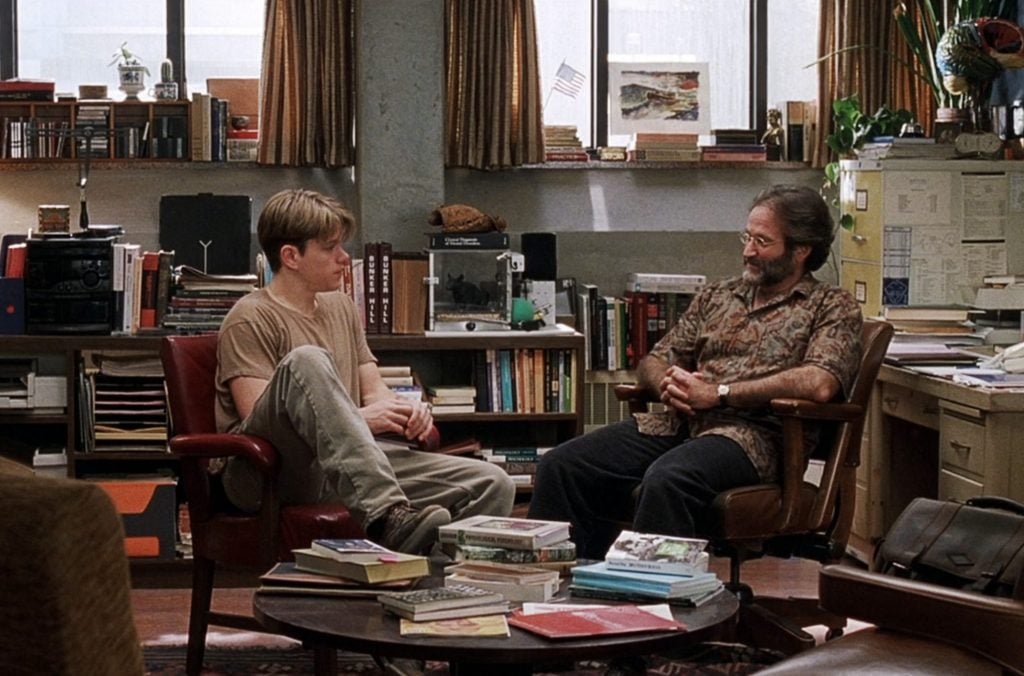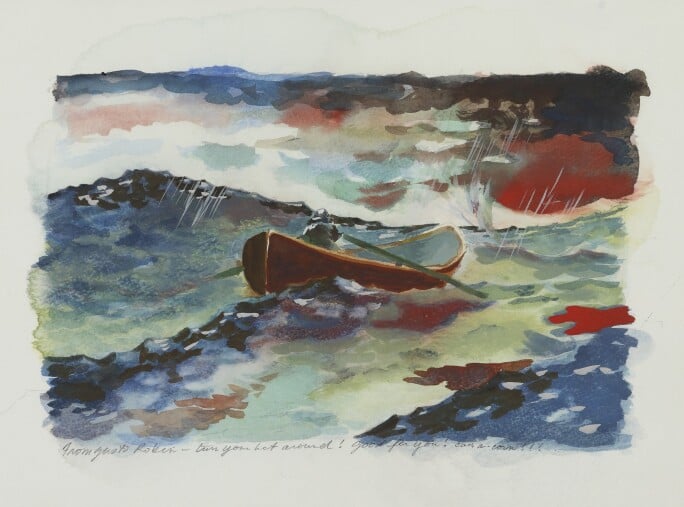Pop Culture
As Seen on ‘Good Will Hunting’: A Winslow Homer Rip-Off by Gus Van Sant
The watercolor propelled a key exchange between Matt Damon and Robin Williams's characters.

The watercolor propelled a key exchange between Matt Damon and Robin Williams's characters.

Min Chen

At the center of 1997’s Oscar-winning film Good Will Hunting is the growing and tender relationship between therapist Sean Maguire (played by Robin Williams) and his new patient, the titular Will (Matt Damon), a janitor at Boston’s M.I.T. and a secret math prodigy.
Their first meeting at Sean’s office in a community college is prickly—the surly Will has only agreed to the session as part of a parole condition negotiated by Gerald Lambeau (Stellan Skarsgård), a math professor who recognizes the young man’s talent. Sean initially attempts to engage Will in conversation about books and, weirdly, physical fitness, but Will ends up drawn to an artwork affixed to the therapist’s windowpane. The watercolor depicts a lone man in a boat, on a stormy sea, the grey sky blotched with red.
“This is a real piece of shit,” is Will’s appraisal of the work. “Just the linear and Impressionistic mix makes a very muddled composition. It’s also a Winslow Homer rip-off,” he continued, referring to the 19th-century painter who favored often-turbulent marine and seascapes.
Sean, likely attempting to diffuse the awkward situation, offers: “You know what the bitch of it is? It’s a paint-by-number.”

Original watercolor painting by director Gus Van Sant, from Good Will Hunting (1997). Photo courtesy of Sotheby’s.
In actuality, the 14-by-10-inch work was created by the film’s director, Gus Van Sant, who had indeed based it off a Homer, specifically The Gulf Stream (1899). (Homer’s art also arguably inspired other frames in the movie.) The filmmaker, who studied painting at the Rhode Island School of Design in the 1970s, conceded in 2018 that probably “we could have played the scene so that you never saw the painting”—except it revealed a point of vulnerability for Williams’s character.
Will, as he continues to study the painting, offers his psychoanalytic take on its maker. “Maybe you’re in a storm, a big fuckin’ storm. The sky’s falling over your head, the waves are crashing over your little boat… Maybe you do what you do to get out,” he tells Sean, before going in for the rub: “Maybe you married the wrong woman.”
Sean explodes at the suggestion (his wife is deceased), physically attacking Will, who merely smirks at this crack in his therapist’s veneer. It’s a scene that illustrates Will’s insecurity and self-destructiveness, but also, Sean’s kindly doggedness. Will’s insensitivity hasn’t turned him off; he will, in fact, take him on as a patient. “Thursday, four o’clock,” he tells Lambeau after the session. “Make sure the kid’s here.”
Williams would go on to land an Academy Award for his role in the film—as well as Van Sant’s painting. The work was included in the 2018 sale of the actor’s collection at Sotheby’s, following his death in 2014. Against an estimate of $1,000–$1,500, it fetched $90,000. At the bottom of the work, Van Sant had inscribed in pencil: “From gus to Robin—turn your boat around! Good for you! Can a-corn!!!”